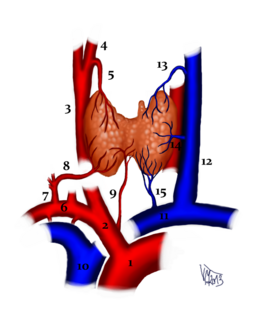Thyroid gland
The thyroid gland (lat. Glandula thyreoidea) is an butterfly-shaped endocrine organ located on the front of the neck. It functionally participates in the regulation of metabolism by production of the hormones triiodothyronine and thyroxine. These hormones affect the metabolic rate, oxygen consumption, growth and development. Another hormone produced by the thyroid gland is calcitonin, which regulates calcium and phosphorus metabolism.
Anatomy[edit | edit source]
The gland consists of the two lobes (lobus dexter et sinister) in shape of the triangular pyramid connected by the isthmus. The pyramidal lobe varies in 1/4th of the cases −> a remnant of the thyroglossal duct stretching upward from the thyroid isthmus.
- Lobes: 5–8 cm long, 2–4 cm wide, 1,5–2,5 cm thick.
The Weight is about 20–60 g (usually greater in women).
- Size and weight of the thyroid gland differ according to sex, age and geographical factor (on average, the size and weight of the gland increases with increasing distance from the sea and with increasing altitude)
The Surface is smooth to slightly bumpy, has the reddish-brown or red-violet color (depend on the blood vessels). It's covered by a fibrous capsule which consists of an inner and an outer layer.
- Outer layer: capsula externa is associated with vagina carotica (common fibrous capsule for a. carotis communis, v. jugularis interna, n. vagus and radix superior ansae cervicalis) and lamina praetrachealis fasciae colli.
- Inner layer: capsula propria extrudes septae and divides the gland into the lobules. Lobules consist of sacs, follicles separated by the soft fibrous tissue, capillary and lypmhatic networks.
- Between both of the layers there are vascular plexuses.
The shape of the gland are variable. The gland can be in shape of the letter H, U or A depending on the location of the isthmus. Bases of the lobes are caudally rounded, and the apexes are pointing cranially.
Location and syntopy[edit | edit source]
The gland is located on the sides of the larynx and trachea , the isthmus lies in front of the 2nd to 4th tracheal ring. It is fixed to the trachea by the ligamentum suspensorium glandulae thyroideae s. Ligamentum Berry.
Syntopy of individual anatomical surfaces of the lobes[edit | edit source]
Facies medialis: is attached to the larynx and trachea, related to the vagus nerve (nervus laryngeus recurrens).
Facies anterolateralis: together with isthmus is covered by the infrahyoid neck muscles from lamina pretrachealis fasciae colli.
Facies dorsalis: is related to vagina carotica, the parathyroid gland is partially immersed there.
Blood supply[edit | edit source]
Cranial part of the lobes is supplied by the superior thyroid artery (5), a branch of the external carotid artery (4), the caudal part is supplied by the inferior thyroid artery(8), a branch of the thyrocervical trunk (7). Both arteries form a vascular anastomosis.
The non-constant a.thyroidea ima (9) from the brachiocephalic trunk (2) or the aortic arch (1) may be present.
The Veins connect together and form the network between the inner and the outer layer of the capsula. The blood from the upper pole of the gland is taken away by vv.thyroideae superiores (13) and vv.thyroideae mediae (14) to the internal jugular vein (12). The blood from the lower pole is taken away by vv.thyroideae inferiores (15) to the left brachiocephalic vein (11).
Lymphatic vessels lead to the subcapsular network and then to lymph nodes of the cervicales profundi.
Microscopic Structure[edit | edit source]
Microscopically, the thyroid gland consists of the round closed follicles. The wall of the follicles is lined by the simple cuboidal follicular cells, that can be changed to the squamous cells due to the hypofunction of the gland. While hyperfunction manifests by changes to the columnar epithelium. The follicles are richly interwoven with sinusoids. All the follicular cells are attached to the basement membrane, their cytoplasm is basophilic and contains a lot of rough endoplasmic reticulum and secretory granules.
Follicles are filled with a colloid. It's a viscous homogeneous fluid which contains mainly glycoprotein thyroglobulin, which is the reason for PAS-positivity of the colloid. Thyroglobulin contains precursors of the main thyroid hormones - thyroxine and triiodothyronine, whose synthesis process takes place in the colloid.
In addition to follicular cells, there are also parafollicular cells (C cells) which produce calcitonin. Unlike the follicular cells, parafollicular cells are derived from the neural crest.
References [ modify | edit source ][edit | edit source]
Related Articles [ modify | edit source ][edit | edit source]
Bibliography[edit | edit source]
- PETROVICKÝ, Pavel. Anatomie s topografií a klinickými aplikacemi. 1. edition. Martin : Osveta, 2001. 560 pp. Chapter 2. ISBN 80-8063-047-X.
- JUNQUIERA, L. Carlos – CARNEIRO, José – KELLEY, Robert O.. Základy histologie. 1. edition. Jinočany : H & H 1997, 1997. 502 pp. ISBN 80-85787-37-7.



